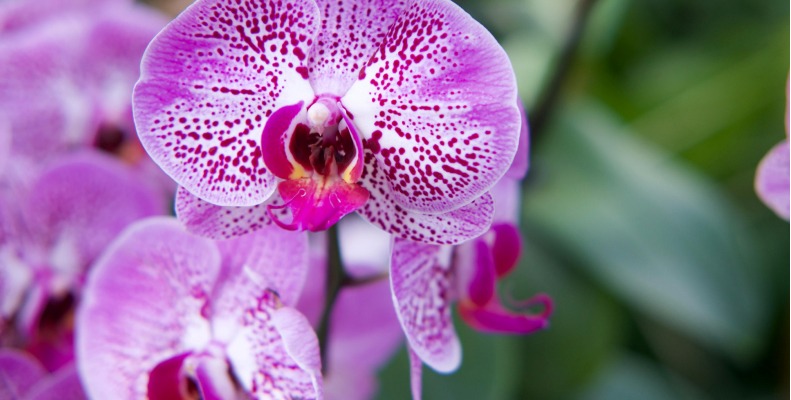The Orchidaceae plant family is very diverse. It includes about 26,000 types, belonging to 880 different genera. Most of these plants grow in tropical areas. They live as epiphytes, which means they grow on other plants.
Some orchids, however, are lithophytes. That means they grow on rocks or among rocks. And others are semi-terrestrials. They grow in soil that drains well. With such a wide variety of orchids, caring for them can be tricky. Each type might need slightly different care.
This guide focuses on giving beginners a good start in orchid care. We will cover key areas like how to water and when to repot. Other topics include the light and temperature needs of orchids. We will talk about fertilizing and how to get your orchids to bloom more than once.
If you’re new to orchids or already love them, this article is for you. It will help you learn how to take care of your orchids. You’ll be able to keep them healthy and blooming beautifully for years.
Key Takeaways
- The Orchidaceae family comprises over 26,000 diverse species, requiring tailored care approaches.
- This guide covers essential orchid plant care topics like watering, potting, light, temperature, fertilizing, and reblooming.
- Whether you’re an experienced orchid grower or just starting, this comprehensive resource will help you cultivate thriving orchid plants.
- Proper orchid care ensures the long-term health and abundant flowering of your indoor orchid collection.
- Understanding the specific needs of your orchid species or hybrids is key to providing optimal growing conditions.
Watering Orchids
Proper orchid watering is key for their health and long life. Always let the potting media dry in between waterings. Remember, over-watering can harm your plant.
The watering ways for orchids can differ. It depends on the type of orchid, potting mix, and your home’s moisture. Generally, orchids require water once a week. Just check the mix by pushing a finger in. If it’s slightly damp, you’re good.
Watering Techniques
One good way to water orchids is to put their pot in warm water for 30 minutes. This bottom watering makes sure the roots get plenty of water. After soaking, let the pot drain well before putting it back. It’s a great way to keep your orchid healthy for a long time.
Orchid Light Requirements
Orchids stand out because of their beautiful flowers. Getting the right light is very important for them. Orchids need bright, but indirect light. An east or west-facing windowsill is a perfect spot for them.
Bright, Indirect Light
Orchids love bright, indirect light. This means they should sit where there’s lots of natural light but without the sun directly hitting them. Too much sun can damage the leaves. The best place for them is where it’s as bright as a greenhouse or under light shade.
Light Preferences by Genus
Orchids need indirect light, but each type has its own light needs. Some like more intense light, while others thrive in the shade. Here’s a breakdown:
- Brighter, more intense light: Cattleya, Neofinetia, Vanda
- Semi-shaded light: Angraecoid, Cymbidium, Dendrobium, Oncidiinae, Stanhopea
- Shaded light: Bulbophyllum, Lycaste, Miltoniopsis, Paphiopedilum, Phalaenopsis, Phragmipedium, Pleurothallidinae
It’s vital to know what your orchid likes in terms of light. This knowledge helps your orchid stay healthy and bloom beautifully.
Orchid plant care
Orchids are unique because they don’t grow in nutrient-rich soil. They need a special orchid fertilizer, like Green Jungle Orchid Food. For best results, dilute the fertilizer to 1/2 or 1/4 strength. Do this about once a month while they’re growing. Reduce to every two weeks when they’re getting ready to bloom.
Fertilizing Orchids
The right orchid fertilizer, used correctly, is vital for healthy plants that bloom well. Regular feeding gives your orchids all the nutrients they need. This way, they can produce beautiful flowers that last a long time.
Ideal Temperatures for Orchids
Most orchids like it best when daytime temperatures are between 70-85°F. At night, they prefer it a bit cooler, around 60-70°F. If an orchid thrives in temperatures outside of this range, it’s classified as either warm or cool-growing. Keeping the orchid temperature in this ideal range is key to having healthy, flowering plants.
Encouraging Reblooming
To get your orchid to rebloom, keep it in the right light, always. Make sure it gets enough water and the right fertilization in fresh soil. It also helps if there’s a night temperature drop of 10°F to kickstart flower spike initiation. But, avoid wet leaves at night because it might cause disease.
Temperature Drops for Blooming
Your orchid needs a temperature drop of about 10°F at night to start blooming. This cooling effect is important. It’s like it’s in its natural environment, telling the orchid it’s time for flowers.

Trimming Flower Spikes
Once the flowers are gone, trim the flower spike about 1 inch above the main stem. Or, if there’s a small bump called a node, cut just 1/2 inch above it. Then, keep track of temperature, watering, and the spikes to help your orchid bloom year after year.
Orchid Potting and Repotting
Knowing how to properly orchid pot and repot is key to keeping them healthy. Orchids need soil that drains well to let air reach their roots. This helps them grow. You can use New Zealand Sphagnum Moss or a mix of pine bark, perlite, and charcoal.
Potting Mix for Orchids
Sphagnum moss is good at keeping nutrients from liquid feed but doesn’t last as long as bark mixes. The mix of pine bark, perlite, and charcoal allows for good drainage and plenty of air. This helps orchids’ roots get what they need.
When to Repot Orchids
Usually, orchids need to be repotted every two years, especially in spring. This is when they’re too big for their pot or the orchid potting mix is worn out. Repotting keeps your plants healthy and strong.
Repotting Technique
For orchid repotting, pick a pot that will suit your plant’s growth for 2 to 3 years. Place the plant with its older pseudobulbs toward the pot’s edge. This leaves space for it to grow and bloom beautifully.
Introduction to Orchid Plant Care
The orchid family is vast, with over 26,000 known species. These beautiful plants vary in shapes and colors. They are loved by many, from beginners to experts in gardening. Knowing how to care for them is crucial for them to flourish.
Diversity of Orchid Species
Orchids have a wide range of growth habits and flowers. Some grow on trees, some on rocks, and others in soil. This variety means there’s an orchid for everyone, each needing its own special care.
Orchids as Houseplants
Many orchids do well indoors, giving you lovely blooms. The Phalaenopsis, for example, is great for your home. It thrives in regular home conditions. With proper care, your orchids can make your space look tropical and beautiful.
Essential Orchid Care Tips
Taking good care of your orchids means understanding their needs for light, water, warmth, and food. If you get these care tips right, your orchid will be happy and bloom again. Let’s learn how to keep your orchids healthy and vibrant.
Conclusion
Many think orchids are hard to care for. But, with the right orchid plant care, they can be successful houseplants. They will give you beautiful flowers that last a long time.
As a beginner, learn the basics like how to plant them, how much to water, and the light they need. Also, understand the right temperature, how to feed them, and ways to make them flower again. With this knowledge, beginners can have healthy and varied orchid collections.
At first, you might only have one Phalaenopsis orchid. But, as you learn, you might want more. This guide helps you on your way to becoming a good orchid grower. All it takes is some time, effort, and a bit of learning. Soon, your home will have a beautiful orchid garden that fills your heart with joy.
Orchids are known for requiring careful attention. But, with good care, they will do well as indoor plants. They will bless you with lovely flowers. To care for orchids well, learn the basics, such as potting, watering, and the light they need. Also, understand the right temperature, how to feed them, and ways to make them flower again. With this information, even a first-time orchid owner can appreciate these amazing plants.

